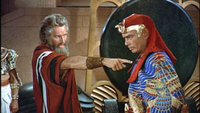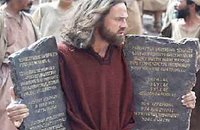The Ten Commandments (1956)

The paradox of The Ten Commandments is that it is one of the easiest films to mock and parody, and yet it's magnificence is such that whenever discussion arises about the biblical epic, and indeed biblical films in general, it's name is never far away.
The films more risible moments begin from the very start as, rather than adopting a more conventional opening, director Cecil B. DeMille steps out from behind the curtain and delivers an almost ten minute lecture arguing for his film's historical credibility. There follows around ninety minutes of fictional hokum as DeMille invents a backstory, a cadre of friends and potential foes, and strings them together with such unintentionally hilarious lines like "Oh, Moses, Moses, you stubborn, splendid, adorable fool!".
And yet, at the same time these scenes also provide some of the film's most stunning moments. Take for example the scene where Moses erects an obelisk as his "brother" Ramsees stands limply by (the phallic symbolism is comically transparent). Yet, despite the fact that Moses completion of the task is never in doubt, DeMille manages to make dramatic and indeed spectacular footage from what is essentially, a construction scene. Thousands toil away in the immense heat of the desert, orchestrated by one man's extraordinary vision, expertise and dedication to create an extraordinary masterwork - a description that suits both what we see on screen and what is going on behind the scenes.
Such parallels between DeMille's story of Moses and the modern day abound, not least because DeMille is determined to convert the story of the Exodus into a Cold War parable. DeMille's lecture at the start of the film concludes that "The theme of this picture is whether men are to be ruled by God’s law, or whether they are to be ruled by the whims of a dictator like... Ramsees" even adding "This same battle continues throughout the world today." The film carries this through in almost every respect from the casting of Russian-born Yul Brynner as Ramsees, through to the all American Heston striking a statue of liberty pose in the film's closing shot.
The film also goes out of it's way to elaborate on the parallels between Moses and Jesus, themselves the results of the Gospel writers' attempts to cast Jesus as a new Moses. As my friend Peter Chattaway observed, almost 20 years ago now, "Pharaoh orders the death of all newborn boys in Goshen, not because he is afraid of population growth, but because a star has prophesied the birth of a deliverer in their ranks". Moses' mother uses the words of the Magnificat when she finally meets her adult son. Joshua calls him "the chosen one". Others talk of how they dared not “touch the hem of his garment”. Moses himself explains his encounter with God at the burning bush in phrases that sound like the Gospel of John, "the Word was God", "his light is in every man" and so on. By reversing what Matthew and the other Gospel writers are trying to do DeMille effectively casts Moses in his own shadow.
The groundwork DeMille puts in during that opening ninety minutes pays off. The burning bush scene may not have aged well, but the scenes where Moses commands his former rival Ramsees to let his people go are as taut as Bryner's shendyt. Ramsees is still trying to win an old argument, but Moses moved on long ago. All the while the spurned Nefertiri is trying to keep the whole thing spinning in an attempt to hurt the man who spurned her and the one who didn't.
When the script finally starts to cover the actual biblical story, the spectacle becomes no less impressive. The eeriness with which the Angel of Death's green mist creeps through the Egyptian streets is a fitting climax to the nine plagues which have gone before. The scene of the Israelites leaving Egypt - a scene which actually delivers on the oft used strap-line "a cast of thousands" - deftly manages to combine the sheer scale of the event with the the individual and personal. An elderly man's dying wish here, and young girl and her dolly there, DeMille manages to take these small moments and make us imagine the impact of that multiplied ten thousand times.
Then, of course, there is the parting of the Red Sea. Film scholars still debate whether or not this version of the tale outdid his earlier silent version from 1923. Either way, both are hugely impressive even in the face of the tidal wave of CGI that dominates special effects today. The two scenes have had such a cultural impact that many today are shocked to discover the Bible actually describes a far more gradual process of the waters parting. So much for the film's repeated line "So let it be written. So let it be done".
And then, finally we get the obligatory orgy and the arrival of the titular commandments. Given his history DeMille was unlikely to pass up the chance to show scantily clad bodies writhing before the golden bull, but it's actually the sparks flying through the air to engrave the Commandments on the rock face which stick in the memory. As with the crossing of the Red Sea, the scene itself bears little resemblance to the corresponding passage from Exodus, where Moses is at the foot of the mountain with the people by his side, but such is the impact of this film that it's rare to find someone who thinks of either scene like the book.
The costumes are, of course, fantastic and the immense sets are first class. Heston, Brynner and John Derek's muscles gleam. Anne Baxter purrs, Vincent Price camps it up and Cedric Hardwicke gets to drily deliver wry witticisms. Even Edward G. Robinson, who fell foul of Joseph McCarthy, gets to join in scowlingly dismissing Heston's bright-eyed pronouncements. Meanwhile Elmer Bernstein - a relative unknown at the time - underpins the story with his classical score. Amazingly whilst the film lasts for 220 minutes, it never feels like that long, no doubt explaining why despite the $13 million it cost to make, it made almost ten times that at the box office and no doubt made it's budget many times over in reruns, home video sales and regular broadcasts at Christmas and Easter.
But perhaps the most significant thing about The Ten Commandments is how it has become the definitive film for so many different categories. Despite decades of westerns and parlour comedies, it's this film that comes to mind when people today think of Cecil B. DeMille. Regardless of Ben-Hur's eleven Oscars, it's The Ten Commandments that is seen as the quintessential Charlton Heston performance. And, of course, it stands as the definitive example of the biblical epic. Few films indeed can claim to be so typical of, and central to, their genre as this. Double Indemnity for film noir. Star Wars, perhaps, for science fiction. Like them it deserves to be put on a pedestal and celebrated, even if we recognise that part of the reason it is so monumental is because time has moved on and we are unlikely to see anything quite like it ever again.
============
Chattaway, Peter (1999) "Lights, Camera, Plagues!: Moses in the Movies" in Bible Review 15:1, February.
Labels: DeMille, Heston, Moses, Ten Commandments (1956)













































